Ukraine's housing market still struggling
House prices have been falling in Ukraine since 2014. This latest quarter - Q2 2019 - is the 22nd consecutive quarter of annual price falls. Yet demand for house purchases continues to fall due to rising interest rates and to Ukraine´s prolonged political crisis. Rents and land values also continue to fall. On the other hand, construction activity is rising.
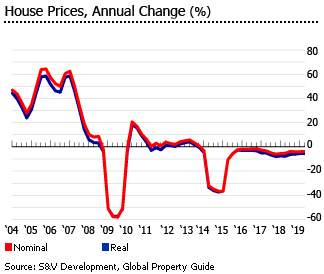
Existing apartment prices in Kiev fell by 3.73% during the year to Q2 2019 (-5.47% in real terms), to an average price of US$ 1,031 per square metre (sq. m.), following y-o-y declines of 3.98% in Q1 2019, 4.03% in Q4 2018, 3.79% in Q3 2018, and 5.31% in Q2 2018, according to S&V Development. During the latest quarter (Q2) existing apartment prices fell 0.67% (-1.87% in real terms).
Likewise, newly-built apartment prices in Kiev fell by 3.74% y-o-y in Q2 2019 (-5.47% in real terms), to US$926 per sq. m. During the latest quarter (Q2), newly-built apartment prices dropped 0.64% (-1.84% in real terms).
Residential property prices have been falling for five years, particularly in 2014 (with prices plunging 36.6%) because ofhryvnia devaluation due to the Russian war. Newly-built and existing apartment prices are down 65% and 72% respectively, from their peak in Q3 2008.
Ukraine’s housing market is expected to remain subdued during the remainder of the year, as homebuyers and investors adopt a wait-and-see approach after the recently concluded April 2019 presidential elections.
The Ukrainian economy grew by 2.2% in Q1 2019 from a year earlier, following y-o-y expansions of 3.4% in Q4 2018, 2.8% in Q3, 3.8% in Q2 and 3.1% in Q1, according to the State Statistics Service of Ukraine. Recently, the National Bank of Ukraine (NBU) raised its forecast for the country’s economic growth for 2019 from 2.5% to 3%, and for next year from 2.9% to 3.2%, due to stronger domestic demand, better terms of trade and the expected increase in grain harvest.
There are no major restrictions on foreigners buying property in Ukraine. All secondary residential transactions (i.e., resales) are in US dollars, while primary sales are quoted in hryvnia, but still paid in dollars.
Land prices are falling
All regions registered land price falls during the year to Q2 2019, based on figures from S&V Development.
- In Kiev region, land values fell by 5.9% (-7.6% in real terms)
- In Odessa region, land prices fell by 6.1% (-7.8% in real terms)
- Donetsk region registered the biggest y-o-y decline of 16.6% (-18.1% in real terms)
- In Dnipropetrovsk region, land prices dropped 4.2% (-6% in real terms)
- In Kharkiv region, land prices fell by 3.4% (-5.1% in real terms)
- In Lviv region, land prices fell by 6% (-7.7% in real terms)
Rents continue to fall
In Kiev, apartment rents have been falling since the onset of the global crisis. From 2012 to 2018, rental rates in the capital city plunged about 45%, based on figures from S&V Development.
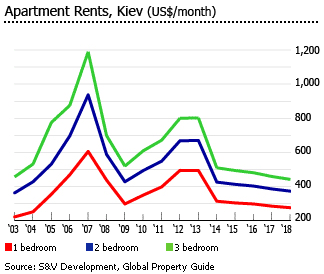
- For one-bedroom apartments, rents were US$273 per month in July 2019, down 2.8% from July 2018
- For two-bedroom apartments, rents were US$368 per month in July 2019, down 2.9% a year earlier
- For three-bedroom apartments, rents were US$438 per month in July 2019, down 3.1% a year ago
The most costly location in Kiev isShevchenkivskyi District, with rents for three-bedroom apartments of around US$578 per month in July 2019, followed by Pecherskyi District (US$552 per month), and Obolonskyi District (US$451 per month).
In recent years, most rent quotations have switched to the national currency, hryvnia, to protect landlords from currency fluctuations.
Residential construction is rising
In 2018, the number of apartments in Ukraine rose slightly by 0.7% to 17.1 million units, according to the State Statistics Service. This means that there were about 113,000 extra apartments units last year – the biggest growth in four years. Kiev accounted for about 6.3% of total apartment stock, or 1.08 million units.
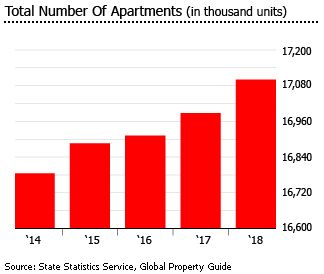
Likewise, the total area of housing stock increased by just 0.9% y-o-y to 993.3 million sq. m. over the same period.
Securing construction permits had become dramatically easier
While corruption remains Ukraine’s number one problem, the ease of doing business, especially securing construction permits, has noticeably improved in recent years. To tackle corruption, the government implemented reforms in various sectors and established corruption fighting institutions. Deregulation has reduced the corruption opportunities for bureaucrats. According to World Bank’s Ease of Doing Businessreports,Ukraine was ranked 71 out of 190 countries in 2019 – up 41 notches from 112 in 2014. This sharp improvement is mainly due to a reduction in the number of mandatory licenses and permits, particularly in the construction sector, and due to a simplified tax system.
In terms of ease of obtaining construction permits, Ukraine has moved 110 notches from rank 140 in 2014 to as high as rank 30 in 2019. Currently, securing construction permits in Ukraine requires 11 procedures, takes 85 days and costs 6.3% of the property value.
Despite the huge improvement, corruption still exists. Those with direct ties to high ranking officials, who are prepared to pay large bribes, usually come out as winners in land allocations. As such, it is not surprising that there are only a few builders in the market. New developments in major cities are typically dominated by two to three companies, whose management is directly linked to the local authorities. In Kiev, nearly 70% of the new residential buildings are built by companies that belong to the KyivMiskBud holding company, in which the Kyiv City State Administration has a large stake.
Interest rates are rising
The decline in housing loans is mainly attributable to rising interest rates. In May 2019 interest rates on US$-denominated housing loans, which account for more than 70% of total housing loans, rose to 17.8%, from 10% in the previous year, according to the National Bank of Ukraine.
The average interest rate on hryvnia-denominated housing loans was 17.8% in May 2019, up from 17.5% in May 2018 and 14.4% in May 2017.
Interest rates on housing loans in Ukraine are usually fixed for the entire loan term. In May 2019, more than 93% of loans had loan terms of 5 years or more, and 73.5% of those were loans for 10 years or more.
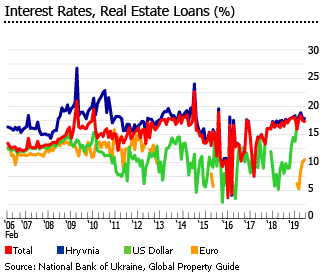
However, housing loans are frequently prepaid before maturity, and it is not uncommon that a 10-20 year loan to be paid within 3 - 5 years.
"Nowadays homebuyers seek loans instead of traditional long-term mortgages, opting for bridge financing where they already have 80-90% of a property’s value in cash and intend to repay their loan in 6-12 months," says AIM Realty Kiev´s co-founder Tim Louzonis.
Mortgage market has been shrinking
From its peak of 10.8% of GDP in 2009, Ukraine’s mortgage market has shrunk to about 1.3% of GDP in 2018, according to estimates from the Global Property Guide. In May 2019, total outstanding loans for house purchases were down by 3.7% y-o-y to UAH 41.19 billion (US$1.6 billion).
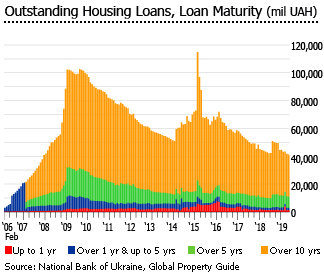
By original maturity:
- Up to 1 year: housing loans were down 21.6% y-o-y to UAH 986 million (US$38.3 million) in May 2019
- 1-5 years: housing loans rose by 19.7% y-o-y to UAH 1.8 billion (US$69.96 million) over the same period
- 5-10 years: loans rose by 14.2% y-o-y to UAH 8.14 billion (US$316.22 million) in May 2019
- Over 10 years: loans fell by 8% y-o-y to UAH 30.26 billion (US$ 1.18 billion) in May 2019
By currency:
- US$-denominated housing loans were down by 6% y-o-y to UAH 29.14 billion (US$1.13 billion) in May 2019
- Hryvnia-denominated housing loans increased 3.8% y-o-y to UAH 10.25 billion (US$398.11 million) in May 2019
- Euro-denominated housing loans rose by 33.9% y-o-y to UAH 804 million (US$31.23 million) over the same period
- Housing loans denominated in other currencies fell by 23.7% y-o-y to UAH 993 million (US$38.57 million) in May 2019
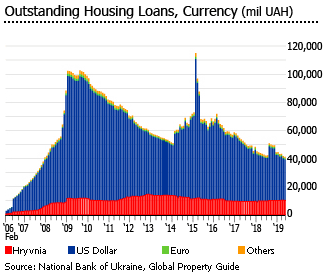
Recovering from bust and war
Ukraine enjoyed an economic boom during the decade 2000-2007 with an average GDP growth of 8% per year, setting off a massive property boom. The hryvnia rose because of the economic growth and foreign investment, but inflation and interest rates began to rise too. The logical conclusion was - borrow dollars on low interest rates, buy Ukrainian property as it rises, then sell and repeat. Easy money.
For a long time it worked. The hryvnia appreciated as economic growth accelerated, and as foreigners invested in Ukraine. The country lived off its massive steel industry (42% of exports). Foreign buyers - Britons, Americans, Emiratis, Cypriots, Kiwis and Canadians - as well as wealthy elite Ukrainians, pushed house prices up by an average of 40% to 55% p.a. from 2004 to 2007. In fact, property prices rose by a total of 442% from 2002 to 2007 (373% in real terms).
Currency inflows increased the money supply excessively, resulting in inflation. Ukraine experienced double-digit inflation from 2004 onwards, and in May 2008 inflation peaked at 31% y-o-y. As a result, Ukraine priced itself out of export markets, imports grew to be much bigger than exports, and the current account deficit expanded to 7% of GDP in 2008.
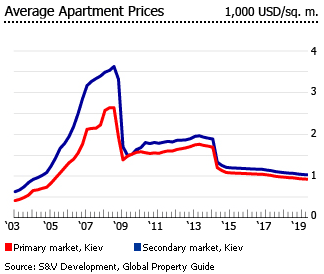
As the contagion from the global crisis spread in 2008, the hryvnia lost over 50% of its value against the US dollar, leading to a loss of consumer confidence in banks and mass withdrawals. Depositors rushed to withdraw their savings from banks and the government was forced to unveil a bank bailout.
In late 2008, the global financial crisis affected homebuyers from US and UK, causing foreign demand to plunge in Ukraine. Meanwhile, demand for Ukraine’s main product, steel, plummeted. Ukraine’s GDP contracted 15.1% in 2009.
On top of this came political chaos. The country’s tragedy is that the Orange Revolution of 2004, which resulted in a clear victory for the Western-oriented Viktor Yushchenko (with 52% votes) over the pro-Russian Viktor Yanukovych, never bore fruit. Yushchenko proved an ineffective leader. He quarreled deeply with his former ally Tymoshenko, who he saw as corrupt and accused of being a covert friend of Russia.
The result of the split in the pro-Western party was the election of a pro-Russian president, Victor Yanukovych, who decided to put off an association agreement with the European Union (EU), which would have provided funds contingent on reforms. Instead, Yanukovych signed an agreement with Russia, which eventually led to his ouster as president in February 2014. He was temporarily succeeded by Oleksandr Turchynov.
Following Yanukovych’s ouster, protests by pro-Russian and anti-revolution activists escalated into an armed conflict between the Ukrainian government and the separatist forces of the self-declared Donetsk and Luhansk People’s Republics. Russia subsequently seized Crimean peninsula and launched insurgency to occupy parts of eastern Ukraine.A ceasefire, called the Minsk Protocol was reached in September 2014, but completely collapsed in January 2015. In February 2015, a new ceasefire agreement, Minsk II, was signed – but unfortunately, has never been implemented. Thousands have been killed in the past four years.
The political crisis adversely affected the economy, which contracted by 0.03% in 2013, 6.6% in 2014 and by another 9.8% in 2015.
Amidst the conflict, Petro Poroshenko, a pro-European chocolate tycoon, emerged victorious in the May 2014 Presidential elections, and in October 2014 his party obtained the majority of seats (132 seats) in parliament.
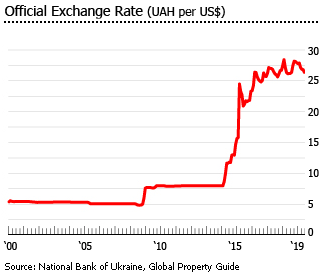
In February 2014 the National Bank of Ukraine announced that they would set a floating exchange rate in accordance to IMF’s requirements. This resulted in an around 70% depreciation of the hryvnia against the US dollar in 2014 and 2015. In 2016 the depreciation of Ukrainian hryvnia continued, and it traded at an average of UAH 25.5 = US$1 in 2016, a decline of around 80% on the previous year. This had a catastrophic effect, as a large proportion of housing loans are denominated in US$, and are now impossible to repay. Out of Ukraine’s total outstanding housing loans, only 17% were denominated in UAH by end of 2016, while loans denominated in US dollars got a huge share of 79%, making the country highly exposed to foreign currency risk.
In the past two years, the currency has been more stable, with the average monthly exchange rate at UAH 26.38 per US$1 on May 2019, almost unchanged from UAH 26.42 per US$1 in May 2017. The currency’s recent stability is mainly attributed to the central bank’s stabilization measures, as well as the optimism regarding the approval of IMF funds.
The economy returned to growth after three years of turmoil. The economy expanded by 2.4% in 2016, 2.5% in 2017 and by another 3.3% in 2018.
In April 2019, television comedian Volodymyr Zelensky won the presidential run-off in a landslide victory over incumbent Poroshenko. Despite the fact that Zelenskiy has never held any elected office before, voters were so tired of economic uncertainties that they were willing to take a risk. In his inaugural address, Zelensky vowed to end the Russian-backed insurgency in the east of the country and announced early parliamentary elections in an effort to capitalize on his popularity.
Like Poroshenko, President Zelensky will also push for Ukraine’s membership to both the European Union (EU) and the North Atlantic Treaty Organization (NATO) – a move that has been strongly opposed by Kremlin.
Economic outlook is positive, amidst renewed peace talks
Ukraine’s outlook remains positive and recently, the NBU raised its forecast for Ukraine’s economic growth for 2019 from 2.5% to 3%, and for next year from 2.9% to 3.2%. “Compared with the April macroeconomic forecast, the National Bank improved its forecast for the economic growth pace…due to a stable domestic demand, better terms of trade and the expected increase in the grain harvest,” said the central bank.
However these economic forecasts are highly subject to revision, due to a cargo blockade on the separatist-held eastern regions, Donetsk and Luhansk.
The blockade arose because separatists had seized control over steel and coal companies in the East, prompting Ukraine’s anti-terrorist operation (ATO) in January 2017 to prevent freight trains from delivering commodities to these areas. Two months later, then President Poroshenko suspended trade links to the eastern Donbass region. But newly elected President Zelensky is determined to end the insurgency and in June 2019, restarted peace talks. This positive development gives renewed hope for a ceasefire to millions living in the embattled Donbass region of eastern Ukraine.
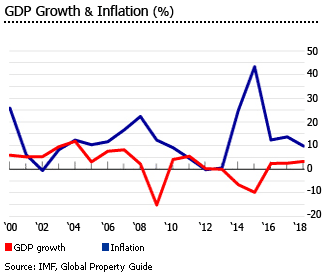
“For the first time the meetings of the working groups were held in a constructive way,” said Ukraine’s new chief negotiator Leonid Kuchma. “All sides wanted to find a solution.” Kuchma also hinted on the possibility of lifting the trade blockade on Donetsk and Luhansk.
Annual inflation was 9% in June 2019, from 9.6% in May, 8.8% in April and 8.6% in March, according to the State Statistics Service. The IMF projects inflation of 8% this year and 5.9% in 2020, a slowdown from 10.9% in 2018, 14.4% in 2017, 13.9% in 2016 and 48.7% in 2015.
Unemployment was 9.2% in Q1 2019, down from 9.3% in the previous quarter and 9.7% a year earlier. Jobless rate is projected to fall to 8.5% this year and to 8.1% in 2020. There were about 1.65 million unemployed people in Ukraine in Q1 2019.
Sources:
- Sale of apartments in the primary market (S&V Development): http://www.svdevelopment.com/ru/web/indicators/
- Sale of apartments in the secondary market (S&V Development): http://www.svdevelopment.com/ru/web/indicators/
- Sale of land (Ukraine) (S&V Development): http://www.svdevelopment.com/ru/web/indicators/
- The cost of renting apartments in Kiev (S&V Development): http://www.svdevelopment.com/ru/web/indicators/
- World Economic Outlook Database (International Monetary Fund): https://www.imf.org/external/pubs/ft/weo/2019/01/weodata/index.aspx
- Monetary and Financial Statistics May 2019 (National Bank of Ukraine): https://bank.gov.ua/doccatalog/document?id=98472677
- Ukraine profile – Timeline (BBC News): https://www.bbc.com/news/world-europe-18010123
- Ukraine country profile (BBC News): https://www.bbc.com/news/world-europe-18018002
- Housing stock (State Statistical Service of Ukraine): http://www.ukrstat.gov.ua/
- ´Corruption in Ukraine has to be stopped´ (BBC News): https://www.bbc.com/news/business-47571043
- Is Ukraine Really Fighting Corruption? Yes, It is (4Liberty.eu): http://4liberty.eu/is-ukraine-really-fighting-corruption-yes-it-is/
- Doing Business 2019 Ukraine (World Bank Group): https://www.doingbusiness.org/content/dam/doingBusiness/country/u/ukraine/UKR.pdf
- Ukraine’s anti-corruption efforts save $6 billion annually: Report (Euromaidan Press): http://euromaidanpress.com/2018/07/26/ukraines-anti-corruption-efforts-save-6-billion-annually-report/
- Why Poroshenko Lost (Atlantic Council): https://www.atlanticcouncil.org/blogs/ukrainealert/why-poroshenko-lost
- Ukraine inflation rate (Trading Economics): https://tradingeconomics.com/ukraine/inflation-cpi
- Ukraine Unemployment Rate (Trading Economics): https://tradingeconomics.com/ukraine/unemployment-rate
- Ukraine- NBU improves economic growth forecast for 2019 (MENAFN): https://menafn.com/1098776440/UkraineNBU-improves-economic-growth-forecast-for-2019
- New hope as Donbas peace talks begin under Zelenskiy (Kyiv Post): https://www.kyivpost.com/ukraine-politics/new-hope-as-donbas-peace-talks-begin-under-zelenskiy.html
- The Donbas Conflict (SWP): https://www.swp-berlin.org/10.18449/2019RP05/
- Ukraine´s new president commits to EU, NATO membership (DW): https://www.dw.com/en/ukraines-new-president-commits-to-eu-nato-membership/a-49057931